#the first echinoderms
Explore tagged Tumblr posts
Text



Found a wild sea star in a tidal channel right in colt state park
#I’m so happy this is the first wild one in the bay I’ve ever seen#sea star#Forbes sea star#my photos#ocean#ecology#echinoderms
2 notes
·
View notes
Text
This just in, starfish are a radially symmetrical head with a stomach.
God I love echinoderms
If you told someone that there’s an entire group of animals that develop butt first as embryos are born bilateral but then grow a radially symmetrical head like a cancer in their side that then bursts out and lives as a completely separate organism from its birth form and moves via hydraulic systems…
They wouldn’t believe you. Yet one of the most beloved cartoon characters is one of them.
#biology#genomics#genome#genomes#genome sequencing#evolutionary biology#echinoderm#starfish#asteroidea#bilateria#Deuterostome#Deuterostomia
5K notes
·
View notes
Text
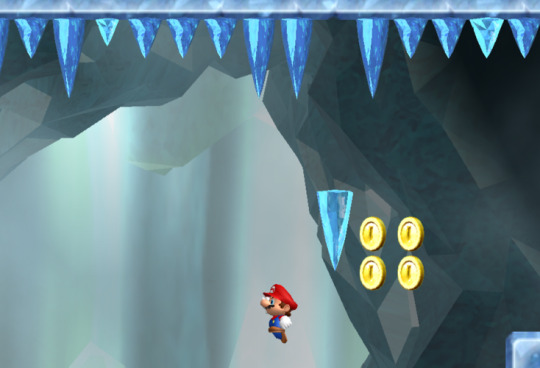
Name: Icicle
Debut: Cold
What is this, a crossover episode? That's right! From nearly the very beginning- since Mario Bros., to be precise- Mario has worked closely with the world's second most beloved public domain ice shape, Icicle!Plenty of us are familiar with Icicle. When it's cold enough, dripping water can freeze into a spike, which, in Mario's case, could potentially fall down and cause quite a booboo.
And it can do that in our case, too! Do you ever think about that? There is a non-extreme weather condition that leads to the formation of temporary SPIKES in our environments. Often dangling right above sidewalks! They're genuinely dangerous! Icicles are an incredible phenomenon. I've never been harmed by one, but I do know it can happen. Also, I've seen one moment of Grey's Anatomy ever in my life, and it happens to be the scene where someone is impaled by a falling icicle. Ouch! Right in the anatomy!

Thankfully, real icicles are not as HOSTILE as the ones Mario has to deal with, because in Video Games World, icicles just LOVE to fall when a scrimblo walks underneath them. Even when it's too far away to justify it as being vibration-based. These slippery spires are doing it on purpose! Mario has also encountered Huge Icicles, which are large and tough enough to stand upon, and one of those would probably do just fine as a table in a snowman's house. Just like an icicle would be a perfect weapon for a snowman, and also a perfect gardening tool, and also a perfect carrot substitute, because a snowman eating a carrot would be almost cannibalism. No, I don't think a snowman eating snow or ice would be cannibalism. We carbon-based creatures eat carbon-based food all the time! Now calm down and imagine a nice bowl of Cream of Icicle Soup.

Honestly, I just wanted to gush about icicles here and used Mario as an excuse. I hope that's okay. If it's not okay, I will not repent. But another thing that makes icicles so video-gamey is that they have, basically, an elemental counterpart, in stalactites! It's almost like convergent evolution, except they are not alive, and never were. And just think of the name! Stalactite. Even if icicles didn't exist, it would make all the sense in the world for a game to reuse the graphic, tint it blue or white, and you got an ice variant! Except they would have called it Stalactice! Unfortunately, I have never in my life encountered a Stalagmice...

There are so many variations of the humble icicle in the world! Have you ever heard of sapcicles? They're incredible! Nature's frozen treats, beloved by all manner of creatures! But please do not lick the sap of a tree you don't know well. Sapcicles are thought to be the way that indigenous Americans first discovered the sweetness of maple sap! And what about brinicles? Underwater icicles! Lethal to any poor, slow-moving echinoderms that may be underneath as they fall... and of course, there is our most beloved elemental spire: the grass/ground type Carrot! The world is full of so many shapes and structures, and I hope you now realize how much fun you can have when you really think about something you once took for granted!
208 notes
·
View notes
Note
what's up with shipworms?
They are wood-eating clams who use their shells to slowly carve through the wood, digest it with symbiotic bacteria (same as termites and other wood eaters) and have very long bodies trailing behind so they can breathe!
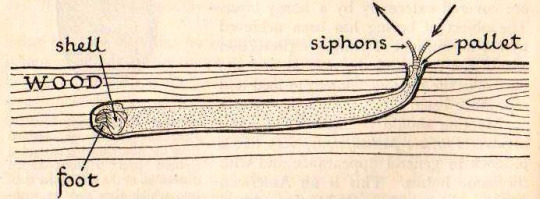
Lots and lots and lots of wood has always wound up in the ocean ever since trees first evolved. Some other wood-eating sea life includes these bizarre deep-sea echinoderms (related to either starfish or sea urchins, I forget) called sea daisies:

And then there are these pitiful wet babies related to isopods, which are called GRIBBLES:

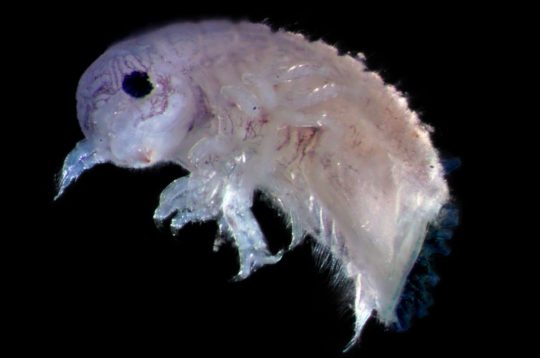
970 notes
·
View notes
Text

We are doing more echinoderm posting I have decided. I love these little hydraulically powered eldritch mini-abominations. <3
At first glance, starfish seem to be all limbs, with five appendages lined with rows of tube feet giving them their signature shape. Marine scientists have long wondered how they evolved to have such anatomy—and where their head might be.
It turns out that, genetically speaking, the animals are actually almost all head and no trunk, according to a new study published in Nature.
(…)
217 notes
·
View notes
Text
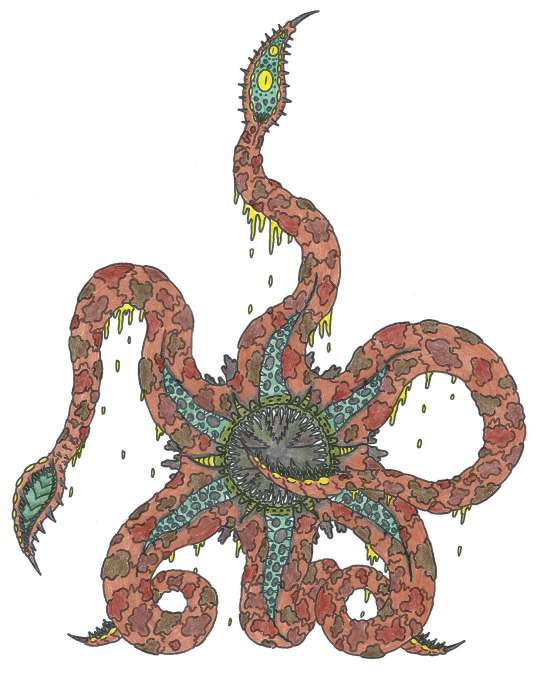
Anything can be an ecosystem, it is just a matter of nutrients and consistency. So often we think that habitats are things that only exist outside our walls, where civilization hasn't fully taken hold. Some folk think we sapient species live completely separate from the natural world, that our lands are omitted from everything else. To them, there is a clear line between what is "nature" and what is "civilization" and once you cross those boundaries, the other ceases to be. But in truth, it is all connected, and our homes are a part of the system like everything else. A city may seem vastly different from any other habitat on the planet, but it is still an ecosystem nonetheless. We are but the fauna running about within, and one of the species that thrives in it. And to the shock of some, there are other creatures that do incredibly well in these man-made habitats, finding living within them just as comfortable as we do.
Sewers and dumps don't seem like much but areas of pure filth, but there is still nutrients to be found. Just because we don't eat the stuff doesn't mean it is useless. Look at the dung beetle, an insect that lives off of fecal matter. While a sewer would be a vile land for us, it would be a paradise to such a coprophage. Things in the wild feed off of waste, it is a natural thing. So when we make areas that are nothing but filth, then some species flock to it, seeing an endless buffet. The Otyugh is one such creature.
When one first sees an Otyugh (probably in illustration over real life), it may be hard to wrap your head around what it actually is. The anatomy seems all over, with arms, legs and heads starting to blur together. Some would claim they are a three-legged species with two tendril arms and a large eye stalk, which is an understandable mistake. The Otyugh is hard to decipher as it moves and feeds, and its anatomy changes depending on the situation. In truth, it is actually a large echinoderm, one that possesses six limbs. Two of these arms are sensory, while the other four are designed for feeding, manipulation and moving. All six have sensory organs for smelling and tasting the world around them, but only two have prominent eyes. These organs are much stronger on these limbs, versus the crude eyes on the others that can only tell between light and dark. All arms work together to help the creature move and feed, though hunting for food isn't exactly a challenge for an Otyugh.
As I made clear, this species is one that feeds entirely on waste, finding poop and filth quite delicious. It isn't just feces, it is anything rotting, foul and discarded that they eat. Their central mouth is a complex arrangement of grinding plates, shredding teeth and potent acid, all designed to consume absolutely everything that gets shoveled in. They are the cleanup crew of the world, like all scavengers, and will erase any detritus or corpse that has been left behind. They are practically immune to poison and disease, devouring plague ridden carcasses without worry. They are essential creatures to areas rife with rot, which is why they have found their way to humanity's sewers.
Otyugh are a species that originally relied on dragons and other megafauna to survive. Their vast amounts of waste gave the Otyugh sustenance, and thus they were commonly found near dragon lairs. Small creatures don't offer enough for such large beasts, but that changed when some species started stockpiling their filth. When the Otyugh caught wind of humans creating places specifically for waste and trash, they were quick to move in. Here was another consistent source of food, in a place that seemed tailor made to them. At first, people were repulsed, but then they realized if they didn't want the Otyugh there, then they would have to go down there and drive them out themselves. Suddenly, no one was complaining anymore.
While most folk don't bother with these creatures, times do come where people do confront them. I know in some big fancy cities, they don't like the image of a giant poop eating seastar dwelling below, so they got the bright idea of getting rid of them. In other cases, their population gets out of control and they start looking for extra sustenance in face of all this competition. Whichever the reason, trying to drive one out or fight it will quickly make you regret your life choices. Otyugh may be sewage suckers, but they can be extremely dangerous. Their tendrils are dexterous and thorny, capable of whipping them with deadly force. Their limbs are many, allowing them to attack from many angles and continue the battle should they lose one or two. The maw in the center of it all is an "everything-grinder," which can reduce an armored warrior to juice if they get too close. On top of all that is the fact that they are dripping with filth and vileness, which can lead to nasty infections or sickness should one be exposed. Sometimes slayers will succeed in killing an Otyugh, only to succumb to a horrible rotting disease weeks later from a mere scratch they had received. In most cases, fighting them is straight up not worth it. It should only be a last resort, for when the Otyugh start spilling out from their sewer homes and begin eating "fresher" things.
To go back to that earlier mistaken description, of a beast with "three legs, two arms and one eye stalk," there is a reason that was a common belief. When Otyugh are feeding, they are laying down in the ocean of filth, positioned like any seastar you would see on the coast. Mouth down, arms out, just enjoying life. When buried in this waste, you can't really see them. Their bodies are colored and designed to fit in with piles of manure and disgust around them (as if anything would want to eat them), and thus folk miss them most of the time. However, when threatened, the Otyugh will rear up to look much larger and expose its pulverizing maw. This is done by using three tendrils for support, like legs. Two feeding limbs are flailed about in a threatening manner, while a sensory tentacle is held high for it to see its attacker. Now that it has made itself obvious and known, people start paying attention. This is why that description became commonplace, as these postures were how folk even got to see them most of the time!
A funny thing to note is that humans are probably way more familiar with the Otyugh than dryads. Honestly, it was a while before I even got to see one myself! This is because dryads collect and compost their waste at home, making sewer systems rare in our towns and cities. Due to large efforts to recycle and reuse, we don't have large areas of the stuff for an Otyugh to settle in. This isn't meant to be a dig at humanity, more just a neat observation. I will say that some dryads made a business of utilizing an Otyugh to rapidly breakdown substances and objects a normal household couldn't properly handle. It is like a rapid transformation of waste into fertilizer, for those who don't want to wait. Bring your junk to these places, let the Otyugh eat it and get its fertile expulsions in return. An odd business, but it seems to be working pretty well! Of course, there are also rumors that some of these establishments earn the real coin from folks who want certain "somethings" to "disappear..."
Chlora Myron
Dryad Natural Historian
-----------------------------------------
"Otyugh"
While this entry is written by Chlora, it is one that I would say is not canon. Mainly because I know the DnD company is incredibly litigious and not fans of their stuff being used anywhere else. I mainly drew this thing up because I thought it would be fun and the entry was me exploring the "what if" scenario.
But hey! An Otyugh that is an echinoderm! Hmm. Like a big ol seastar! Hmmm! Perhaps like a starfish! HMMMMMM!
96 notes
·
View notes
Text
Round 3 - Chondrichthyes - Heterodontiformes




(Sources - 1, 2, 3, 4)
While several extinct genera of Heterodontiformes are known from the Jurassic, today only one genus, Heterodontus, the “Bullhead Sharks” remains. Ten living species of bullhead shark have been described.
Bullhead sharks are relatively small, with the largest species reaching just 1.65 metres (5.5 ft) in maximum length. They have tapered bodies, with blunt, proportionally large heads, relatively small mouths, pig-like snouts, and pronounced ridges above their eyes. They have two large dorsal fins, the first larger than the second, and an anal fin. Both dorsal fins have a rigid spine at the front of each fin which is used for defense. Bullhead Sharks are bottom feeders in tropical and subtropical waters. They have cusped grasping teeth at the front of the mouth, and flattened teeth at the back of the mouth. They use the flattened teeth at the back of their mouth to crush hard-shelled prey like bivalves, crustaceans, and sea urchins, and the grasping teeth on soft-bodied prey like worms, anemones, and octopuses. They hunt at night by "walking" along the sea floor with alternating motions of their pectoral and pelvic fins.
Bullhead shark egg cases are shaped like an auger, with two spiral flanges. This allows the egg cases to become wedged in the crevices of rocky sea floors, where the eggs are protected from predators; however, some bullhead sharks deposit their eggs on sponges or seaweed. Due to their spiral shape, each egg case requires several hours to rotate out of the mother shark's cloaca (Oof). She usually lays two at a time. The eggs typically hatch after 7 to 12 months, depending on the species. The pups will usually reach over 14 cm in length by the time they leave the egg case.
The Heterodontiforms appear in the fossil record in the Early Jurassic, with modern forms appearing in the Late Jurassic. Despite the very ancient origins of the genus, phylogenetic evidence indicates that all living species in the genus arose from a single common ancestor that survived the K-Pg extinction.

Propaganda under the cut:
Female Japanese Bullhead Sharks (Heterodontus japonicus) are known to deposit their eggs in communal nests, with as many as 15 eggs left in the same nest.
Horn Sharks (Heterodontus francisci) (image 2) have relatively small territories they hunt in at night, returning to the same “house” during the day. They may remain faithful to the same territory for over a decade. Now that’s a homebody.
Horn Sharks are queued by light rather than by an internal clock. In laboratory settings, they will become active as soon as lights are turned off. If they are in the middle of something when the lights are turned on, they may stop swimming and sink to the bottom. In one experiment where the sharks were kept in darkness, they remained continuously active for 11 days before slowing from fatigue. (☹️)
The Horn Shark generates the highest known bite force relative to its size of any shark, which it uses to crack into mollusks, echinoderms, and crustaceans. One study found the average bite force for this species in the wild to be 95 N with a maximum of 135 N, while under experimental conditions sharks could be induced to bite with over 200 N of force.
Female Horn Sharks in the wild pick up their egg cases in their mouths and wedge them into crevices to keep them safe.
In July 2018, three people were arrested after stealing a juvenile Horn Shark from the San Antonio Aquarium. The shark was scooped out of its tank and smuggled out of the aquarium in a stroller, wrapped in a wet blanket. It was thankfully returned unharmed two days later.
The Crested Bullhead Shark (Heterodontus galeatus) (image 4) produces spiral-shaped egg capsules that are secured to seaweed or sponges with long tendrils.
The Crested Bullhead Shark is a major predator of the eggs of the Port Jackson Shark! Individual sharks have been observed taking the egg capsules in their mouths and chewing on the tough casing, rupturing it and allowing the yolk to be sucked out, or simply swallowing the capsules whole.
The Port Jackson Shark (Heterodontus portusjacksoni) (image 1) is a migratory species, traveling south in the summer and returning north to breed in the winter. Males tend to arrive to the breeding grounds first with the females arriving later and staying later, perhaps as a means to reduce egg predation upon their newly laid eggs.
While juvenile Port Jackson Sharks are not particularly social, adults are often seen resting in caves in groups, and prefer to associate with specific sharks based on sex and size. In lab settings, these sharks were shown to have unique personality traits and preferences, can be trained, can count, and can learn by watching other sharks.
66 notes
·
View notes
Text
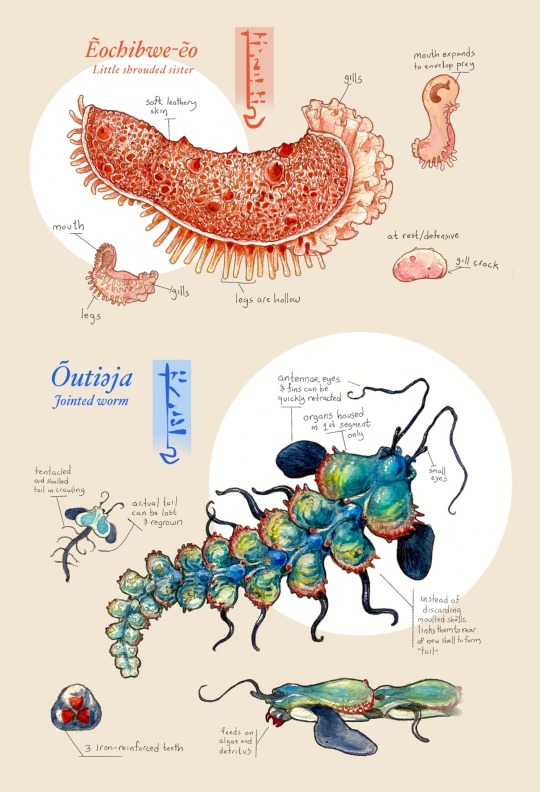
Illustrations and notes on two small invertebrate animals found along the Twowi coastline.
The first is a soft bodied creature from a diverse family of benthic invertebrates characterized by lack of eyes, echinoderm-like tube feet, and an ability to generate copious amounts of mucus from the dermis. Affectionately referred to as “little shrouded sister” in the local language, this creature is a rare but handsome find in the bottom of deep pools during Twin Moon tides, when the water recedes the furthest. It defends itself from predators with acrid tasting toxins in the mucus coating its “shroud”, which are released within seconds of being attacked. According to local legend, they are born of unfed larvae thrown into the sea, which survived by latching onto the backs of fish.
The second is a shelled animal whose name means “jointed worm”, though another common moniker is the “mud-rattle”. It gets this name from its peculiar shell, which links to each previous molt to form a long, articulated tail reminiscent of a rattlesnake’s. However, this armored tail carries no warning; it is simply an eye-catching distraction. As long as the vital organs in the first segment remain unharmed, this worm can live to grow another tail. They inhabit muddy sea floors across a wide swath of the world’s oceans, and range in size from just 2 cm to more than a meter. Ease of collection and tender flesh make this creature a popular seafood; boiled, steamed, or fried; it is arguably the “shrimp” of birg cuisine. The handsome shells are also commonly re-articulated for a second life as rattles and jewelry.
________
Also available as a print!
Patreon | Kofi
827 notes
·
View notes
Note
Hey! I have some questions about water animals.
1. Sorry if this is a bit morbid, but I read in a book a few years ago that vets use clove oil to euthanize fish, and do they still do that?
2. Are there any other animals besides starfish, sponges, and jellyfish that don’t have brains?
3. Are jellyfish the only ones without hearts?
4. I know now that most of the stuff in Blackfish is bunk but is there anything right in there? If so, what? I know Dawn Branchau really died and I know about the first Shamu, but was any of the other stuff in there right, or was it literally just the two facts and then a bunch of BS?
5. Read somewhere that dolphins can do math, is that correct?
Yes! Clove oil is considered an acceptable method of euthanasia for fish. Its active ingredient, eugenol, induces painless loss of consciousness and then death. But I would always advise consulting with a veterinarian before making end-of-life decisions for a pet fish. All animals, fish included, deserve dignity and care.
Jellyfish are cnidarians, an enormous phylum of animals (including corals and sea anemones) that do not have brains. Neither do echinoderms like sea stars and sea urchins. However, many of these animals still have rudimentary nervous/sensory systems that allow them to interact with their environment. Except sponges. They have nothing.
Basically none of the animals I mentioned above have hearts either!
It's been a long time since I watched Blackfish, but as far as I know, there are no completely fictious stories in it. The issue lie more in the interpretations of factual events ("Tilikum killed Dawn Brancheau = he's psychotic from captivity") and, to a lesser extent, the use of misleading visuals (i.e., footage of an orca with its mouth open "screaming," when orcas vocalize entirely through their blowholes).
They can recognize numbers, but we do not know if they can perform mathematics the way a human does.
37 notes
·
View notes
Text
You can feel his eyes on you by the time you’re finishing up with the elementary schoolers, and before you turn to address Jotaro, you make sure to remind the young boy who’d just been staring wide-eyed at the echinoderms you handled gently in your hands while lecturing to walk, not run, out of the exhibit. He nods emphatically, and his first step, more of a skip, slows to a stiff walk immediately, which makes you giggle.
Jotaro takes this as an opportunity to move closer finally, polite and careful around you as always. His hands are shoved in his pockets as you suspected, and he forces an expression of feigned indifference on his features as he approaches, but there’s no reason for him to be tailing you so closely as you handle the visiting school children on Marine Science day, and yet he does. It’s only because the most interesting thing in this entire aquarium has always ever been you.
If only he had the courage to say it out loud.
“Are you diving with me next week?” he asks as you dry your hands on the side of your cargo pants and give him your full attention. He’s dressed in the same uniform as you are, although still insisting on wearing his lab coat around the place - something about the long sleeves and long length part of his personal style - and you wonder, as your eyes pass over the width of the cling of the fabric of the cotton polo shirt to his chest how easily you could swim in that coat yourself.
Rather than dwelling in the thought, you raise your eyebrows at him.
“Am I not on the list?” you ask. Jotaro blinks, realizing his question, only meant to segue naturally into a conversation with you, only managed to confuse you.
“No, I mean, yes. You are.”
So why are you asking? should be your natural reply, but you allow him enough mercy but addressing the subject tangentially. “Is it your first one?”
“No.”
“Mm. That’s good.”
As you continue to engage him in chatter, you’re looking around, making sure the kids did not leave any papers or knock anything over. There’s not too much to sweep, but Jotaro follows you, like some kind of pensive shadow, as you search in a hidden door along the walls of the decorated open plan room for the utility closet. He holds the door open for you wider as you search for a broom, watching you carefully, reaching for the accompanying dustpan before you can.
“Is it yours?” he asks. You give him a nod in the affirmative as you sweep, and you can tell that he already probably knew that. He pauses for a moment, and the environment remains still around you, aside from the run of the constantly running water in the tanks, sea creatures moving too close to the surface of the water, and the sound of the broom’s bristles brushing against the soft carpeted floors.
These quiet moments with Jotaro are often like this, where you can tell what he’s saying in his heart is far more than anything he’s willing to say aloud. Sometimes you wonder if that ghost he swears follows him, the one that won’t let him come to any harm, the one that he insists is fond of you as well and won’t let you come to any harm, be it land or sea, knows the depth of his heart.
You’d like to know a little about it too, but for now you settle with letting him learn to speak his mind.
“I only asked because I didn’t want you to be worried,” he finally admits. “Because it’s your first time and because you looked a bit concerned back at our meeting.”
You stop sweeping for a moment, and look up towards him. He’s not the type to blush or frown, but even if he’s looking in your direction, the dustpan appearing small and silly in his hand, he makes sure his eyes don’t look directly in yours, but at a fixed point behind you.
“Will your ghost protect me?” you tease.
His eyes focus back on you, a crack of a smile on his face.
“You don’t think I could?”
Your face warms, and you regret not having as good of a poker face as he does. Perhaps because you don’t have a ghost to confide all your feelings to, them instead being written all over your face.
“I trust you,” you offer.
This widens his smile, as he steps closer to you, bending down to receive the pile of dust you’ve collected before you.
Always ready to make your life easier in any way he can.
“Good.”
#jotaro x reader#jotaro kujo x reader#daydreams: jjba#mimi's notes#jotaken#i'm actually not sure if i posted this before#LMAOOOO
129 notes
·
View notes
Note
OMG it was so nice to read about your blog! I'm on my knees praying to you like a god for some Polka-dot man x reader headcanons. preferably romantic or smut (whatever you feel comfortable writing) I just wanna give him the love he deserves <3
((He's my fucking MAAAAAAAN! I'm so glad other people like him!
Polka-Dot Man Relationship Headcanons SFW + NSFW
SFW Headcanons
So I’m not going to get too into the weeds of how you guys got together because I already covered that in OT3 fic. But suffice is to say that it’s gotta be slow-burn friends to lovers 30k words 40 chapters. So when you finally do start dating you’re already pretty comfortable with each other. In a lot of ways that makes things easy. But knowing when to take it slow and how exactly to transition your relationship from a platonic one to a non-platonic one takes time. You spend the first week or so dancing around each other trying to bait the other into making first moves, like him nudging his hand against yours during a movie, or you leaning in so you can “get rid of an eyelash”. Eventually he breaks and asks to hold your hand and you both hopefully learn that you have to use your words to get what you want!
Living with the virus outside Belle Reeves is difficult. He can’t go more than six hours before the initial symptoms start to show. There's very few safe places for him to expel his dots without major property damage. The safest option, albeit not the most environmentally friendly, is a backyard or a private place in a local park. Anywhere where large amounts of matter can be displaced with little damage to infrastructure. Maybe you can cut a deal with the city's waste management department lol. There's also the physical side effect. As much as he desperately wants to fit in, it can be hard when there's a big glowing hazard sign threatening to burst out of his face. It can make going out in public anxiety-producing, which doesn’t help anything. He was given a more subtle power dampening collar as part of his parole. This helps him sleep through the night but comes with its own unpleasant side effects like headaches and nausea. Not to mention that any sort of medical equipment or restraints are mildly triggering. Like a lot of chronic/long term medical problems, there's no easy fix, you just have to establish care plans, stick to what works and try to be patient when things don't work out.
For related and unrelated reasons, dates can be kind of hard. So many years of only seeing the same four walls until eventually seeing a different same four walls have left him desperate for any and every experience he can. But that can easily swing back the other direction, leaving him overstimulated from all of the noise and bright lights and people all bearing the face that haunts him. He wants to do all the things he could only read about in books or watch on TV when he was younger. He wants to try new foods and go to new places and just have fun for once. But sometimes it’s just too much, especially in particularly loud, crowded, or otherwise overwhelming places. And then that leads to a new wave of frustration and anxiety because he wants so badly to do normal couple things with you but it feels like he always ruins it. He doesn’t of course but it’s hard to not feel frustrated. Though that isn’t to say there aren't plenty of fun things to do together, you just have to work your way up to the big stuff. His favorite date you’ve been on was probably the trip to the aquarium. It was so beautiful and peaceful! Although he did insist that you just move on past the Echinoderm exhibit. Also fun pseudo/at-home dates include Mystery Meal Nights in which you try to find a new take-out place or at least a new food from one of the classics. And, while he won’t instigate it, he does really like dancing with you. He likes it in general, but unless he’s mildly to majorly drunk he won’t dance in public. So you can have little living room dance parties with just the two of you~ He doesn’t dance particularly well, but that just makes it more fun. Dance comes from the heart and that, he has plenty of.
So sort of paralleling the sensory issues I’ve already mentioned. He is simultaneously extremely touch-starved and desperate for affection, but will also sort of out of nowhere get touched-out and just kind of need space. For the first half of his life he was pretty much exclusively around family, and then was put into solitary for most of the rest of it. And now he has you! Someone he loves so so much and wants to hug and kiss and cuddle and all the other things boyfriends are supposed to do. Sometimes it’s just still too foreign and overwhelming, although the longer you two date, the easier it gets and the less often these moments occur. But on the flipside, when he does feel touchy, he might as well be made of Velcro. Every time you cross a new line of acceptable relationship behavior (hand-holding, kissing, etc.), he just adds that to the list of things he’s constantly trying to do. Sometimes he’s just so happy it doesn’t feel real, like he’s going to wake up and it will all be some crazy dream. Nothing in his real life could actually be this nice. He doesn’t articulate it when he feels like that, but you’ll know it by the way his breath shudders when he holds you close, or he holds you extra tight, murmuring an apology in your ear but not letting go. Not yet. Just in case.
NSFW Headcanons
(Under the Cut)
So related to the above, that touch starvation definitely translates sexually. While he eventually mellows out, especially early on in the relationship there's a sort of barely restrained desperation in everything he does. He doesn't ever instigate or suggest something new but the second you suggest or okay something he jumps on it. He just doesn't want to scare you off or push you, even if you want him just as badly. Whenever you're making out, he tries to press as close to you as humanly possible. His kisses are uncoordinated and a little sloppy but his eagerness is sexy in its own right. He's just been so pent up with no outlet or even privacy until now. And he was pining after you for so long. Can you blame him for trying to make up for lost time?
This man is sooooo desperate to please. He's just head over heels in love with you. You've brought so much joy and love to his life, he wants to show you how much he loves and appreciates you. (At a less sexy time, it'd probably be good to talk with him about that feeling of debt and how you love him for who he is, not what he can do for you. But that’s a whole other demon.) So that being said, he’s pretty flexible. While he’s not exactly adventurous, he is open to suggestions. If you want him to take charge, he’ll do his best! Or he’s happy to follow instructions and let you take the lead. Service-Vers. Though, while he’d never ask for it because pleasing you is at the forefront, he’d really enjoy getting to be a pillow prince every once in a while. Just smothered in affection while you take care of everything and spoil him. He’d probably die of happiness.
To be perfectly honest, he’s pretty vanilla. But that’s not a bad thing! He likes gentle, romantic love-making in a bed with the lights dimmed. While he’s not opposed, per say, to trying something new every once in a while, he doesn’t really need anything other than you to make him happy. No matter how many times you two have sex it never gets old or feels less special. If anything it just gets better the more familiar and comfortable he becomes with your body and his own. He likes missionary best but is also a fan of really any position where he can hold you close and see/kiss your face. The one sort of kink he has is praise, though I’d argue everyone likes praise a little. Please tell him how he’s doing and how good you’re feeling. That he’s handsome and good and most of all: that you love him~ He never gets tired of hearing you say it~
#dc imagine#polka dot man#gender neutral reader#abner krill#abner krill x reader#polka dot man x reader#dc headcanons
80 notes
·
View notes
Text

Patreon request for rome.and.stuff (Instagram), and my first plesiosaur (well, first since I was like… 10)
Pliosaurus funkei!
Pliosaurs were a family of plesiosaurs that eventually lost their stereotypical long-necked, small-headed body plan. Resembling the mosasaurs that would come much later, pliosaurs had short necks with large, strong jaws, and fed on fish, cephalopods, and marine reptiles. The type genus, Pliosaurus, contains at least 6 species. The first and type species, P. brachydeirus, was described and named by Sir Richard Owen in 1841.
Between 2004 and 2012, a new species of Pliosaurus was in the process of being uncovered. Before it was formally described or even named, news of this giant sea monster escaped into the general media and it was dubbed “Predator X”.
This Predator X prompted a media frenzy… there were articles estimating its size based on the fragments found so far, a 2009 television special on the History channel, and a segment in the 2011 BBC documentary series “Planet Dinosaur.”
Predator X was reportedly the “most fearsome animal ever to swim in the oceans!”
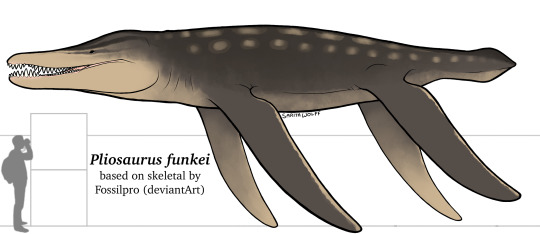
When Pliosaurus funkei was finally formally described and named in 2012, it was found to be a bit smaller than the giant 15 meter long estimate being thrown around. However, it was still a very large animal, around 10–12 m (33–39 ft) long with a 2.0–2.5 m (6.6–8.2 ft) long skull. It also had very long flippers, probably to aid in maneuverability and speed. Analysis of Pliosaurus funkei’s skeleton show that it likely used its front flippers to cruise, only using its back flippers for quick bursts of speed when pursuing prey. Analysis of its brain case shows that its brain was proportional to that of a modern great white shark. So while it didn’t quite beat the Late Cretaceous 12–15.8 meter (39–52 ft) long mosasaur Tylosaurus, the Early Miocene to Late Pliocene 10.5-20.3 meter (34-67 ft) long shark Otodus megalodon, or even the modern day 11-16 meter (36-52 ft) long Physeter macrocephalus (Sperm Whale), it was still no doubt the apex predator of its time and environment.
Pliosaurus funkei lived in the last era of the Late Jurassic in the icy waters of Norway. Found in the Slottsmøya Member of the Agardhfjellet Formation, it would have lived in a cold, shallow sea rife with methane seeps. These methane seeps supported a high amount of diversity, and the Slottsmøya was teeming with ammonites, bivalves, gastropods, brachiopods, tubeworms, echinoderms, cold water sponges, and more. Many icthyosaurs and plesiosaurs would have enjoyed feeding on the plentiful invertebrates here, as well as each other. Pliosaurus funkei would have likely fed on other plesiosaurs like Colymbosaurus, Djupedalia, Ophthalmothule, and Spitrasaurus, as well as icthyosaurs like Cryopterygius, Undorosaurus, Arthropterygius, Nannopterygius, and Brachypterygius.
#my art#SaritaDrawsPalaeo#Pliosaurus funkei#Pliosaurus#pliosaur#predator x#plesiosaurs#sauropterygians#reptiles
86 notes
·
View notes
Text
You know what Alola has a lot of? Water. And when there’s lots of water you get lots of aquatic Pokémon. Welcome back to the series where I discuss the real-life inspirations of every aquatic, non-fish Pokémon. This time I’m covering gen VII. To see previous entries in this series see gen I part 1, gen I part 2, gen II, gen III, gen IV, gen V, and gen VI. For my previous series where I covered the origins of all fish Pokémon see here. As before, starters and legendary/mythical Pokémon will be covered in a separate series. I’ll also cover ultra beasts separately, so no Nihilego this time.
Starting things off we have Marenie and Toxapex bringing us the first echinoderms since gen I. While Staryu and Starmie were generic starfish, the Marenie line are based specifically on the crown-of-thorns starfish.
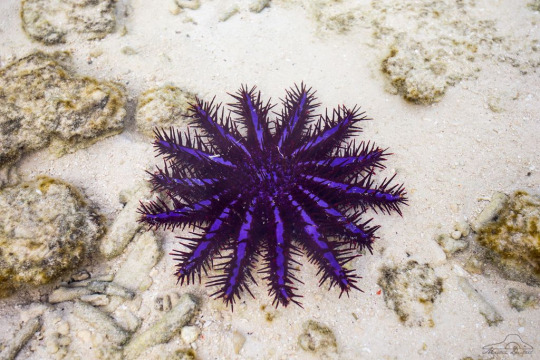
(image: a crown-of-thorns)
These are large starfish covered with venomous spines. The spines are used for defense as they (and the starfish’s other tissues) are filed with a chemicals called saponins. While there is no mechanism for injecting venom, any animal punctured by a spine will get the venom in the wound. It is hemolytic, causing destruction of red blood cells, which can lead to the injured animal suffocating or bleeding out. In addition, the spines are brittle and can break off and get stuck in a wound. In humans, the venom can cause sharp, stinging pains, persistent bleeding, and swelling and nausea for up to a week after the sting. The persistent nature of the pain and hemolysis may be the basis for the line’s signature ability “Merciless”. The other big feature of the crown-of-thorns is its diet. They feed on coral polyps by everting their stomachs onto coral and digesting them externally. This is why the line are specifically stated to prey on Corsola. Too many crown-of-thorns in one coral reef can badly damage it, hence why Toxapex is said to leave a trail of Corsola horns in its wake. Toxapex also takes influence from the hā’uke’uke or helmet urchin, a species found in Hawaii that is shaped very similar to Toxapex’s tentacles when they are all down.

(image: a hā’uke’uke)
Dewpider and Araquanid are based on diving-bell spiders. These spiders spend almost their entire lives underwater, the only species to do so. They do still need to breathe air and so used a coating of water-repelling hairs to carry a bubble of oxygen with them when they are underwater, surfacing occasionally to refresh their supply. The Dewpider line are the inverse of that: a species that can only breathe water and need to bring a bubble of water with them while they live on land. Because of this, they may also be based on sea spiders, a group of marine arthropods that look very similar to spiders. This origin is more noticeable with Araquanid, which has the skinny body and long legs of sea spiders. In both species, the bubble over the head is based on a diving helmet.
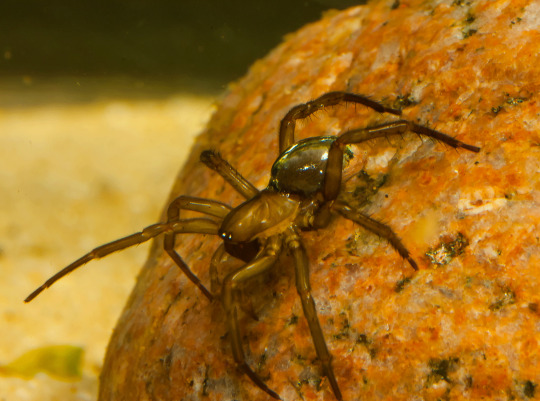
(image: a diving bell spider with its air bubble visible)
Wimpod is one of my favorite gen VII mons and its origin is complex. It is based on a variety of aquatic arthropods. Most notably it resembles an isopod while having a head similar to a trilobite.
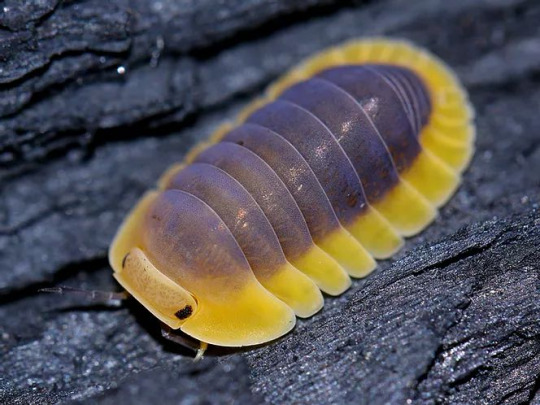
(image: a terrestrial isopod)
It also looks like a copepod, which are zooplankton that have prominent antennae. Fun fact: Plankton from Spongebob is a copepod.
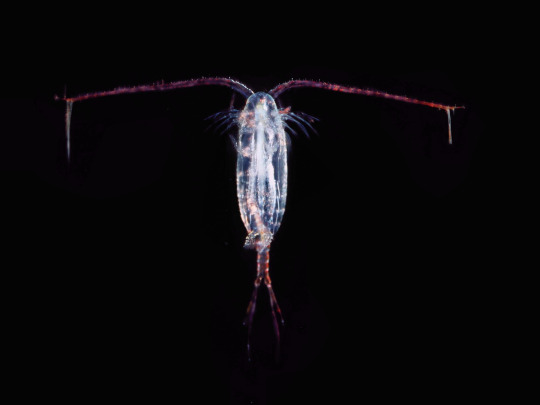
(image: a copepod)
Wimpod’s behavior of fleeing at the first sign of danger is very similar to silverfish. These are insects with a similar body shape to Wimpod that are famous to coming out in the dark and fleeing once the lights come on.
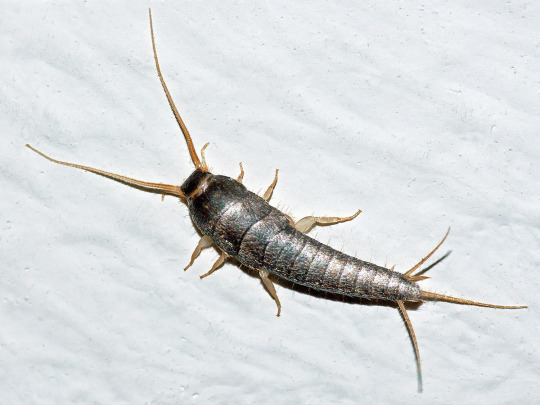
(image: a silverfish)
Wimpod’s habit of eating almost anything and leading a clean path as it travels makes it effectively a living Roomba. As Golisopod, it is based on the giant isopod, a group of species that are much larger than the average isopod thanks to deep-sea gigantism. This is a phenomenon where animals living in the deep ocean become larger than their shallow-water relatives and has a number of proposed causes. The largest and most famous of the giant isopods reaches a maximum recorded length of 50 cm (19.65 in), which is still quite a bit shorter than Golisopod’s 2 m (6’7”). It is also based on samurai as its shell resembles samurai armor and some of its behavior (such as meditation) comes from samurai stories. Its ability to cleave the air in twain with its claws likely comes from classic exaggerations of a warrior’s ability. Golisopod doesn’t care much for a samurai’s code of honor though, as it will happily fight dirty and run from fights.
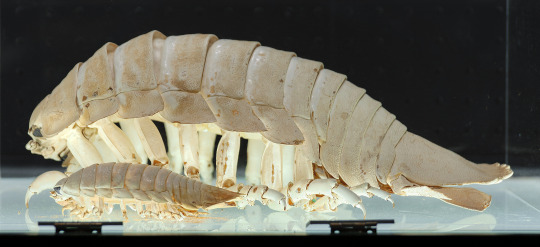
(image: preserved specimens of two giant isopod species)
Gen VII was a good one for echinoderms as coming off the hells of the starfish Marenie line we get a sea cucumber in Pyukumuku. Sea cucumbers have a pretty simple body plan, basically looking like tubes. Their most famous ability is a defense strategy some species employ where they can eject part of their guts to deter predators. In real sea cucumbers, the ejected guts will regenerate while in Pyukumuku, they can retract back into the body and even act like a hand. Sea cucumbers also have external gonads that look like strings. The fluffy tail Pyukumuku has is actually its genitals. The spikes on top might be based on sea urchins, which are relatives of sea cucumbers.
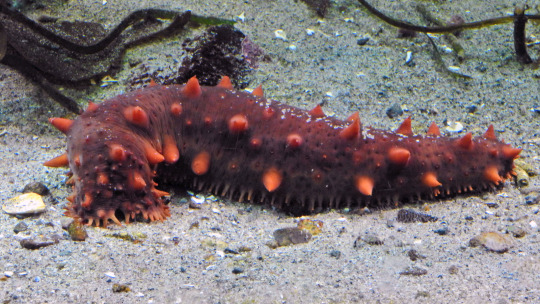
(image: a sea cucumber with similar spines to Pyukumuku)
Our final Pokemon for today is Dhelmise and it’s a weird one. An anchor and ship’s wheel bound together and possessed by the ghost of seaweed. What confuses me is that it’s a wooden anchor. It turns out wooden anchors were used at one point in early boats, but were phased out in favor of ones made of iron. Dhelmise being haunted parts of ships is reminiscent of tales of ghost ships, though on a smaller scale. The seaweed on it may be dead man’s fingers, which grows small tendrils and the name is obviously fitting for a ghost-type.
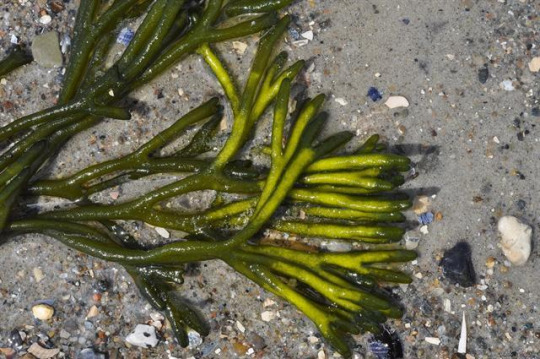
(image: dead man's fingers)
The shiny version having red seaweed could reference red tide, a type of algal bloom that can turn parts of the ocean red. Dhelmise hunts Wailord, meaning it may have been a part of a whaling ship and now the ghosts within it are carrying out their last tasks endlessly, a common trope in ghost stories. It may also reference Moby Dick’s Captain Ahab and his obsessive quest to kill the white whale.
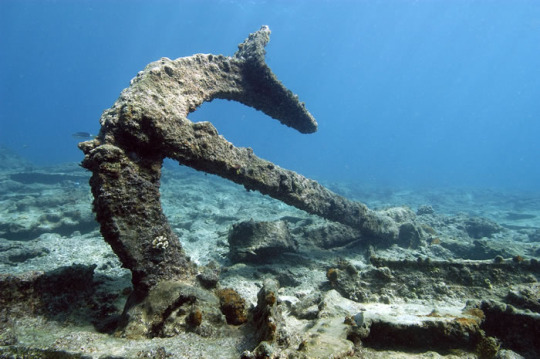
(image: a sunken anchor from a shipwreck in Hawaii's Papahānaumokuākea National Monument)
That’s all for now. Return next time when we go to Galar.
#pokemon#pokemon biology#pokemon lore#pokemon origins#marine biology#aquatic biology#animal facts#zoology#marenie#toxapex#dewpider#araquanid#wimpod#golisopod#pyukumuku#dhelmise#starfish#crown of thorns#diving bell spider#isopods#trilobite#copepods#giant isopod#sea cucumber#echinoderm#anchor#silverfish
228 notes
·
View notes
Text
Please look at this absolutely batshit proposal that apparently nematodes and hagfish are related.
(looking at the guy who runs the blog, he's apparently notorious among palaeontologists for making shit up, didn't expect it to find him in a topic like this)
@siph-by-induction
18 notes
·
View notes
Note
hey im here for sea urchin knowledge, do i have to ask you to detect yourself first or can I just ask for the urchins directly
you can ask for sea urchin facts :3
One i recently found is that the word "urchin" comes from an old English word for hedgehogs, but that's a rather small fun fact
Like all echinoderms they're bilaterians, that secondarily developed radial symmetry (they won't be perfectly radially symmetrical if you look at it closely) and have hydraulically actuated tube feet connected to the water vascular system
I wanted to add something about littoral adaptations sea urchins may have against dessication, specifically trying to find stuff about the atlantic purple sea urchin, but as it turns out there's three kinds with "purple sea urchin" as a common name ↓
Strongylocentrotus purpuratus, Paracentrotus lividus, and Arbaica punctulata
I did however find an article about their clinging strengths → https://archive.org/details/publications-seto-marine-biological-laboratory-19-001-001-015/page/14/mode/1up
Detection for you (according to what i can see on your profile):

10 notes
·
View notes
Note
i absolutely love the small zoology facts youve been putting in from the shadows of the deep. hearing about cnidarians last chapter and the echinoderms this chapter is really reminding me why i chose to major in the subject in the first place and making me want to drop out of college a little less now LMAO.
even though were only three chapters in, i think this fic is really gonna help me get through the rest of this semester, and with a couple rereads, maybe even the rest of my undergrad years. so even though it was probably just a small thing for you, thank you for kinda reigniting my love for zoology at a time where i was really close to losing it. <3
AWWWWWWWW YAYYYYYYY Y PLEASE DON'T DROP OUT YOU CAN DO THIS!!! I BELIEVE IN YOU!!!
And that honestly makes me feel so much joy that this fic has reignited your love for zoology/biology!!! I was honestly on the fence about including so many specific details, but ultimately decided to because it is something that means a lot to me and makes it more fun for me to write. And based on the overwhelmingly positive response I have gotten about it thus far, I am very glad that I chose to be a bit self-indulgent, so seriously, thank you so much!!! I really appreciate your kind words <3 Good luck with the rest of your semester!!!
16 notes
·
View notes